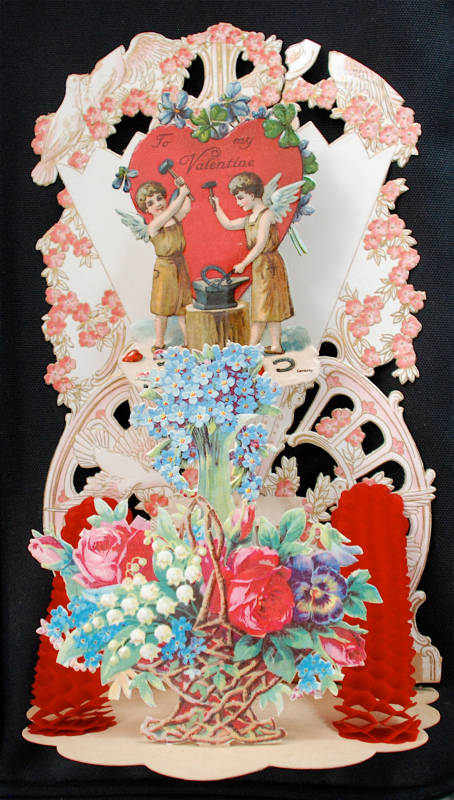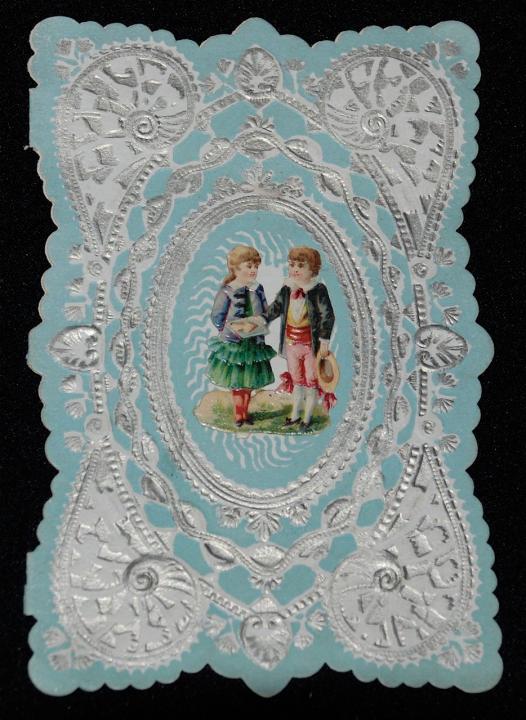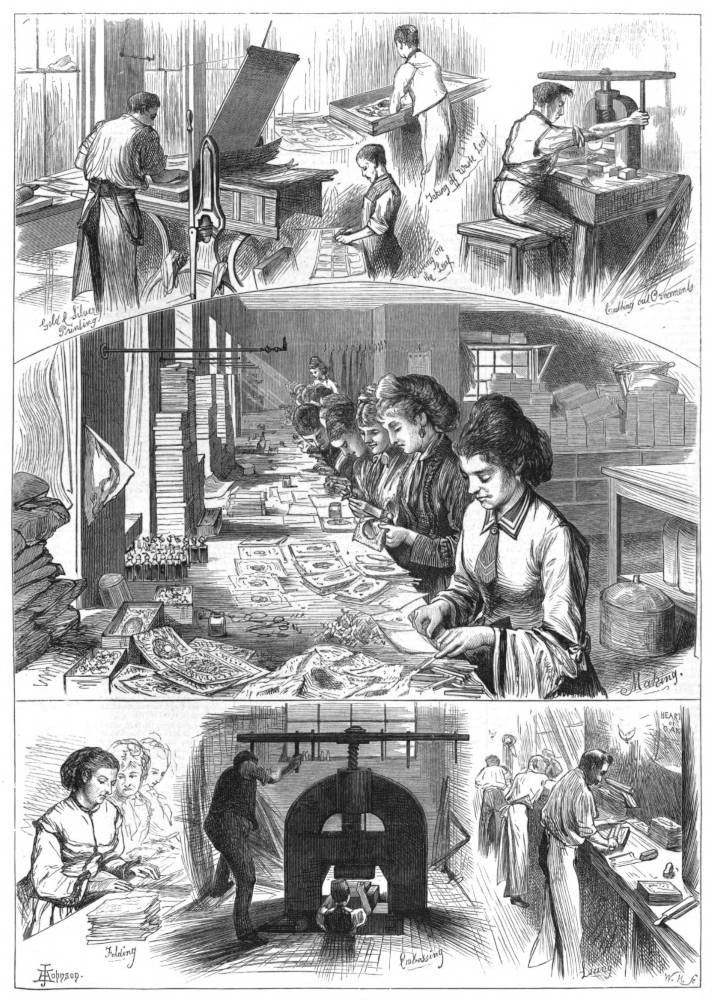The Penny Post had a profound impact on the sending of valentines. In 1841, one year after Uniform Penny Postage, 400,000 valentines were posted throughout England. By 1871, three times that number passed through the General Post Office in London alone (Mancoff 46).
The exchange of Valentine’s Day cards long predates Victorian times: legend has it that the Duc D’Orléans started the tradition in 1415 by mailing his fiancée a missive when imprisoned in the Tower of London. However, in England, the Valentine’s Day card tradition began in earnest in 1840 with the coming of the Penny Post and the prepaid postage stamp, both credited to Rowland Hill. The reduction of postage made sending valentines affordable for the masses.



Left: An American valentine with fine detail. Middle: A mechanical or pop-up valentine. Right: Punch on the flood of Valentines. [Click on thumbnails for larger images.]
One popular Victorian poem written around 1840 and attributed to James Beaton aptly predicted how sending valentines would take off when one could post a valentine for only a penny:
The letters in St. Valentine so vastly will amount,
Postmen may judge them by the lot, they won't have time to count;
They must bring round spades and measures, to poor love-sick souls
Deliver them by bushels, the same as they do coals. [Qtd. in Hyde 289]
The opening issue of Household Words (March 30, 1850) — a weekly miscellany Charles Dickens edited in the 1850s — likewise includes an amusing article entitled “Valentine’s Day at the Post-Office,” written by Dickens with his assistant editor, W. H. Wills. Fascinated by the ”vast amount” of letters passing through the General Post Office in London, Dickens and Wills describe “The sacrifices to the fane of St. Valentine — consisting of hearts, darts, Cupid peeping out of paper-roses, Hymen embowered in hot-pressed embossing, swains in very blue coats and nymphs in very opaque muslin, coarse caricatures and tender verses” (8).

The Manufacture of Valentines. Illustrated London News 64 (14 February 1874): 152.
Victorian valentines adorned with hearts, cupids, flowers, angels, swains, and nymphs function as emissaries of love. Rather than purchase a ready-made valentine as we commonly do today, Victorian men and women often assembled original valentines from materials they purchased at a stationer’s shop: lace, bits of mirror, bows and ribbons, seashells and seeds, gold and silver foil appliqués, silk flowers, and clichéd printed mottoes like “Be Mine” and “Constant and True.” Victorian valentines commonly feature flowers and churches or church spires. Victorians knew well the sentiments that different flowers represented and put them on valentines to express meaning without words. In the “language of flowers,” according to Kate Greenaway’s 1884 glossary, a red rose means love (55), daisies mean innocence (15), bluebells stand for constancy (10), and forget-me-nots represent “true love” (18). Churches or spires signify honorable intentions and assure fidelity in love.
Also popular were novelty valentines that took the form of banknotes from the “Bank of True Love” or telegrams from “Loveland.” Mechanical valentines have moveable tabs; when a viewer pulls a tab, a gentleman’s head nods or, in bawdy valentines, a woman’s skirt raises. The “coarse caricatures,” as Dickens and Wills call them — also known as “vinegar valentines” in the US — may startle readers today.
Offensive valentines, typically sent anonymously, insult a lady as well as a dandy for their looks or poor fashion sense. Others chide a suitor for his mercenary motives in courtship or tell him to “butt out.” Valentines tease bachelors about remaining single and urge them to marry. Marriage was also ripe for ridicule. A widely distributed novelty valentine called the “Map of Matrimony” literally transforms Victorian courtship into an actual map. The valentine (which has different versions) scorns the “Land of Spinsters” and makes light of the entire courtship process, including “Mountains of Delay Inhabited by Lawyers,” “Jealousy Isles,” the “Sea of Propriety,” “State of Agitation,” “Wedding Cake Land,” “Province of Jewellers and Milliners,” and the “Region of Rejoicing,” the only desirable destination” (Bradford, n.p.).
Common in the Victorian era, insulting valentines have all but vanished from our card shops, and handmade valentines appear most frequently in elementary school classrooms. Valentine’s Day cards still flourish. E-valentines are, however, on the rise, but just as in Dickens’s time, on Valentine’s Day we still depend on the Post Office to deliver our heartfelt wishes “by the bushel.”
Related material
Bibliography
Bradford, Emma, ed. Roses are Red: Love and Scorn in Victorian Valentines. London: Albion Press, 1986.
Dickens, Charles and W. H. Wills. "Valentine's Day at the Post Office." Household Words: A Weekly Journal. (March 30, 1850): 7-12.
Golden, Catherine. Posting It: The Victorian Revolution in Letter Writing. Gainesville, FL: University Press of Florida, 2009.
Greenaway, Kate. Language of the Flowers. 1884. New York: Avenel Books, n.d.
Holder, Judith. Sweethearts and Valentines. New York: A & W, 1980.
Hyde, J. Wilson. The Royal Mail: Its Curiosities and Romance. London: Simpkin, 1889.
Mancoff, Debra N. Love's Messenger: Tokens of Affection in the Victorian Age.. Chicago: Art Institute of Chicago, 1997.
“Vinegar Valentines.” Wikipedia. Web. 2 July 2010.
Last modified 10 May 2021